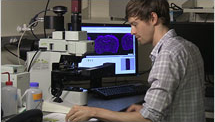The Takeaway
- With an improved understanding of narcolepsy, researchers are now developing novel methods for treating the disorder.
- Some programs are investigating ways to increase brain levels of histamine, a wake-promoting neurotransmitter.
- Other laboratories are developing methods to restore orexin signaling in the brain.
Over the past 10 years, researchers have made great advances in understanding the underlying biology of narcolepsy, and these insights are now leading to new and possibly more effective treatments for narcolepsy. Some current research programs to develop innovative treatments are described below.

Modulating GABA signaling
Some researchers hypothesize that narcolepsy and related disorders of excessive sleepiness may be caused by a chemical in the brain that enhances signaling by GABA. In general, drugs that increase GABA signaling are sedating, and research suggests that some people with narcolepsy have evidence of enhanced GABA signaling, though this is debated.4-6 Clarithromycin, flumazenil, and pentylenetetrazole can block GABA receptors. Although most patients treated with these drugs had other forms of excessive sleepiness, some had narcolepsy. Clinical trials are now underway to test the efficacy of these drugs.
Dr. Scammell outlines some current themes in narcolepsy research.
Restoring orexin signaling
Narcolepsy with cataplexy is caused by a loss of the brain cells that produce orexin. Research in animal models of narcolepsy suggests that excellent improvements in all symptoms could be obtained by restoring orexin signaling. However, this is a challenge in clinical practice, as the orexins are relatively large molecules that cannot easily get into the brain. Some pharmaceutical and academic laboratories are now developing drugs that mimic the effects of orexins, and results in animal models of narcolepsy are quite encouraging.7,8 Early research in people with narcolepsy also looks promising and clinical trials are now recruiting patients to study these drugs further.
Other methods being considered include gene therapy and stem cells. For example, other cells in the brain could be coaxed to produce orexins to make up for the loss of the normal orexin-producing neurons. This approach has been very effective in reducing cataplexy and sleepiness in experiments using mice with narcolepsy.2, 3
In addition, one could reintroduce new orexin-producing cells into the brain using stem cell techniques. This method would take an individual’s own cells, convert them into orexin-producing cells in the lab, and then place these cells into the brain to restore orexin signaling. Treatments for narcolepsy based on gene therapy or stem cells are exciting, but they could fail and produce harmful side effects if people with narcolepsy have an immune response to the orexin peptides. Much more research is needed before these can be developed into safe and effective treatments for people with narcolepsy.
Treatments for narcolepsy based on gene therapy or stem cells are exciting, as they could produce lasting improvements without the side effects of current medications. Much more research is needed before these can be developed into safe and effective treatments for people with narcolepsy.
References
- Lin JS, Dauvilliers Y, Arnulf I, Bastuji H, Anaclet C, Parmentier R, Kocher L, Yanagisawa M, Lehert P, Ligneau X, Perrin D, Robert P, Roux M, Lecomte JM, Schwartz JC. An inverse agonist of the histamine H(3) receptor improves wakefulness in narcolepsy: studies in orexin-/- mice and patients. Neurobiol Dis 2008; 30:74–83.
- Kantor S, Mochizuki T, Lops S, Ko B, Clain E, Clark E, Yamamoto M, Scammell TE. Orexin gene therapy restores the timing and maintenance of wakefulness in narcoleptic mice. Sleep 2013; 36:1129–38.
- Liu M, Blanco-Centurion C, Konadhode R, Begum S, Pelluru D, Gerashchenko D, Sakurai T, Yanagisawa M, van den Pol AN, Shiromani PJ. Orexin gene transfer into zona incerta neurons suppresses muscle paralysis in narcoleptic mice. J Neurosci 2011; 31:6028–40.
- Trotti LM, Saini P, Koola C, et al. Flumazenil for the treatment of refractory hypersomnolence: Clinical experience with 153 patients. J Clin Sleep Med. 2016;15:1389-94.
- Trotti LM, Saini P, Bliwise DL, et al. Clarithromycin in gamma aminobutyric acid-related hypersomnolence: A randomized crossover trial. Ann Neurol. 2015; 78:454-65.
- Dauvilliers Y, Evangelista E, Lopez R, et al. Absence of gamma-aminobutyric acid-a receptor potentiation in central hypersomnolence disorders. Ann Neurol. 2016; 80:259-68.
- Yukitake H, Fujimoto T, Ishikawa T, et al. TAK-925, an orexin 2 receptor-selective agonist, shows robust wake-promoting effects in mice. Pharmacol Biochem Behav. 2019; 187:172794.
- Irukayama-Tomobe Y, Ogawa Y, Tominaga H, et al. Nonpeptide orexin type-2 receptor agonist ameliorates narcolepsy -cataplexy symptoms in mouse models. Proc Natl Acad Sci USA. 2017;114:5731-6.